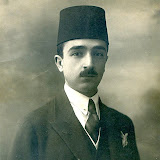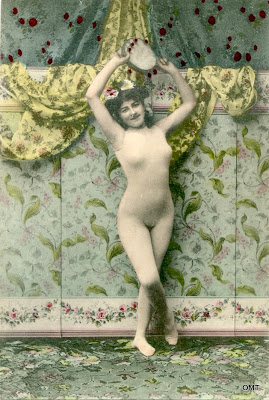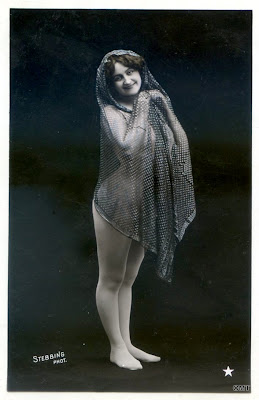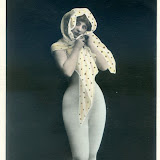Reading 6 cabinet cards
“Photograph people as they really are - do not dress them up”
Henry Peach Robinson
1:What we see isn’t always the whole picture.
There are probably hundreds of thousands of cabinet card portraits taken in studios using elaborate backdrops. The photographer, Whittemore, went to a lot of effort or expense with his studio stages; note the fake grass and the landscape behind disappearing into mist. Still, it’s not that remarkable, except that Whittemore was based in Ashland Nebraska, about as mid-west American as you could ask for in the 1890s. Reading Ashland’s local histories it quickly becomes apparent that the chroniclers struggled to come up with anything interesting to say. This was a farming town, hemmed in by snow in the winter, prone to unpredictable weather the rest of the year, a place for sodbusters who wanted to do it hard. Even at its height, when the railroad brought in more trade, the population barely exceeded a thousand. This cabinet card is a portrait but it is also a highly contrived fiction. From the cheap plaster plinth and faux moss on the wall to the woman’s elaborate hairstyle, it is a fantasy about a world far removed from Ashland. There doesn’t appear to be a lot of information about a photographer called Whittemore in Ashland though a Frank Whittemore ran a saloon in town and the name crops up in 19th century Nebraska registries, suggesting the family were early settlers or at least were successful in business.
2: We are not always sure what we are looking at.
Is this a man or a woman? His or her face is sufficiently ambiguous and though the hands look more masculine than feminine it is the hairstyle that begs the question. Note the painted art nouveau dresser on the left, the floral decorations and the bust on the table. If it is a he then he is stating his position as an urbane sophisticate, an arts student possibly and nothing too remarkable about that. If it is a she then the implications are obviously much more subversive. Note the ring on the middle right finger, or don’t. Some brief research via Google indicates that for some people a ring on this finger is a sign the wearer is gay. There are just as many who see no significance in it. There does not seem to be any evidence it was worn as a symbol of sexual preference in turn of the century Germany but there is a tradition that when a woman bought the ring herself this was the finger she should wear it on. This is a photo you could look at for hours, analysing the significance of every detail without being confident you had arrived at an answer. It is of course possible that this was what the photographer and the sitter wanted.
3: The devil is in the details
Here are late 19th century Balkan politics boiled down to less than 100 words: four empires, the Russian, the Ottoman, the German and the British, have their own motives for maintaining influence in Bulgaria, the only common ground two of them sharing being a desire to keep the other two out. Serbia and Greece want a say in affairs too. The Bulgarians meanwhile want their own state, which the four powers are very keen to see happen, but on their individually specific terms. One sop to this mess was the Principality of Bulgaria, established in 1878 and nominally subject to the Ottoman Empire, a situation that satisfied no one.
The capital of the short lived principality was Turnovo, which was where Adolphe Bornfen set up his studio some time in the late 1880s. He probably took this photo in the early 1890s. At first glance it follows all the rules for a typical family or wedding portrait but several details are important. The first are the crucifixes the women wear. In opposition to the Ottomans who had ruled Bulgaria for 500 years, Christianity was inextricable from the Bulgarian National Revival. By wearing the crucifixes the two women appear to be making a quiet though pronounced stand. The woman on the right, presumably the man’s wife, also wears national dress, not something she’d put on in daily life. Is it a wedding dress? The man’s costume is typically Bulgarian though it is borrowed heavily from Ottoman traditions. This may not be a political image though its politics are everywhere.
4: Or not, as the case may be.
Another cabinet card by Bronfen. It appears to have been taken a few years later. To call yourself supporter of Bulgarian independence might not have been such a big deal in the 1890s. If you were Bulgarian you were, the only issue being which faction you supported; populist and democratic or a sympathiser with more militaristic ideals. We can’t say what side Bornfen belonged to. Though the man on the left wears a sword he doesn’t appear to be a soldier; an aide de camp perhaps or a government man in ceremonial dress. If so, the man on the right would be a politician or bureaucrat. Once you start looking for political meaning it crops up all over the place. The clouds could suggest some celestial ideal, but then they may just be a studio trick.
5: Truth is stranger than fiction
Henry Peach Robinson is one of the most significant photographers of the 19th century. His composite images such as Fading Away and When the Day’s Work is Done are considered landmarks and he is credited with coming up with the term ‘Pictorialism’. The several books he wrote on photography were manifestos for establishing photography as a fine art, but like thousands of others in Britain his main business was in the studio. Interesting, you might think, that for someone famous for using a battery of special effects, this portrait relies on entirely natural props. Information on the back dates this as post 1878, a period when Robinson was at his most dogmatic in declaring how and why photographers should aspire to art, but then his theories were always somewhat anachronistic. He still believed for example that art should reflect truth.
6: Less is more.
At first glance this woman appeared to be in the throes of emotional disturbance but it was her dark velvet top with its sharply angled shoulders and her somewhat aversive posture that gave that impression. She doesn’t look entirely comfortable with being photographed, otherwise she seems the image of the prim and respectable teacher or governess; someone well versed in Latin or French history and worn down by a succession of pupils who couldn’t care less. If this were a standard carte de visite, about a third the size, certain details such as her pince-nez and the texture of her clothes would be lost. The large format of cabinet cards gave us more information, in this case just enough to want to look twice.
 |
| CABINETS OF CURIOSITY |

































